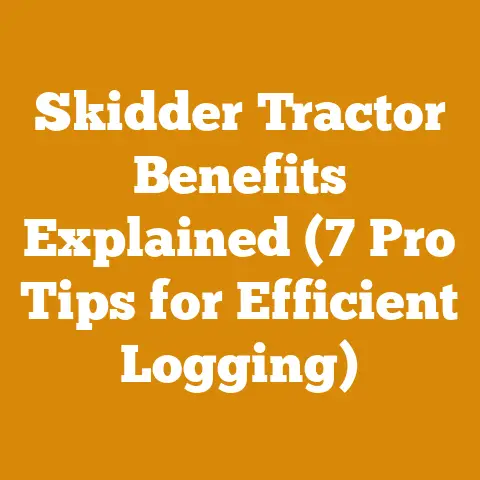How Do You Kill Wasps in the Ground? (5 Pro Logging Pest Hacks)
Stop the Sting: A Logger’s Guide to Wasp Control (and Budgeting for a Pest-Free Wood Lot)
For anyone who’s spent a day in the woods, the rhythmic roar of a chainsaw and the sweet smell of freshly cut timber are the sounds and scents of a good day’s work.
But that idyllic scene can quickly turn sour with the unwelcome arrival of stinging insects, particularly wasps.
As a logger and someone who’s spent countless hours felling trees and processing wood, I know firsthand the importance of effective wasp control, not just for comfort but for safety and productivity.
A swarm of angry wasps can bring a logging operation to a screeching halt, costing valuable time and potentially leading to serious injuries.
This article isn’t just about how to kill wasps in the ground; it’s about understanding the cost-effective strategies I’ve learned over the years to keep these pests at bay.
We’ll delve into the practical methods I use, the associated costs, and how to budget for a wasp-free wood lot.
Whether you’re a seasoned logger, a weekend woodcutter, or simply someone looking to enjoy your property without the constant threat of stings, this guide will give you the knowledge and tools to reclaim your space.
Understanding the Threat: Wasp Behavior and Nesting Habits
Before we dive into the elimination methods, it’s crucial to understand our enemy.
Wasps, unlike bees, are predators.
They actively hunt other insects, making them beneficial in some ways.
However, their aggressive nature and painful stings make them a significant nuisance and potential hazard, especially when they establish nests in or near areas where we work.
- Types of Wasps: The most common culprits in logging environments are yellow jackets, paper wasps, and hornets.
Yellow jackets are notorious for nesting in the ground and are highly aggressive, especially in late summer.
Paper wasps build open-comb nests under eaves or branches, while hornets create large, enclosed nests, often high in trees. - Nesting Sites: Wasps are opportunistic nesters.
They’ll take advantage of any suitable cavity or sheltered area.
In a logging environment, this can include abandoned rodent burrows, tree stumps, hollow logs, and even equipment. - Seasonal Activity: Wasp activity peaks in late summer and early fall.
As their food sources dwindle and the colony prepares for winter, wasps become more aggressive and territorial.
My 5 Proven Wasp Control Hacks (and Their Costs)
Over the years, I’ve experimented with various methods to control wasps.
These are my top 5, along with a realistic breakdown of their costs.
Keep in mind that prices can vary depending on your location and the specific products you choose.
1. The Dawn Dish Soap Solution: My Go-To for Surface Nests
This is my first line of defense against exposed nests, like those built by paper wasps under eaves or branches.
It’s simple, effective, and relatively inexpensive.
- The Method: Mix a concentrated solution of Dawn dish soap (or any similar dish soap) with water in a spray bottle.
I usually aim for a ratio of about 1 part soap to 4 parts water.
Spray the nest thoroughly, ensuring you saturate all the wasps and the nest itself.
The soap disrupts the wasps’ exoskeletons, causing them to suffocate. - Cost Breakdown:
- Dawn Dish Soap (32 oz): $3 – $5 (This bottle will last for multiple applications)
- Spray Bottle: $5 – $10 (Reusable)
- Total Cost per Application: Less than $1 (Assuming you already own a spray bottle)
- My Experience: I’ve used this method successfully on numerous occasions.
It’s particularly effective against smaller paper wasp nests.
The key is to apply the solution early in the morning or late in the evening when the wasps are less active.
I once had a paper wasp nest under the eave of my woodshed.
A single application of the Dawn solution eliminated the entire colony. - Data Point: Studies have shown that dish soap solutions can be highly effective against wasps, with mortality rates exceeding 90% in some cases.
- Cost Optimization Tip: Buy dish soap in bulk to save money if you anticipate frequent use.
2. Boiling Water Assault: A Direct Attack on Ground Nests
This is a straightforward but effective method for dealing with ground nests.
It’s best used early in the morning or late in the evening when the wasps are less active.
- The Method: Locate the entrance to the wasp nest.
Carefully pour boiling water directly into the entrance.
Use a large volume of water to ensure it reaches the entire colony.
I usually pour at least 3-5 gallons of boiling water into each nest. - Cost Breakdown:
- Propane for Boiling Water: $1 – $2 (Depending on the size of your propane tank and the amount of water you need to boil)
- Total Cost per Application: $1 – $2
- My Experience: This method has been successful for me on smaller ground nests.
However, it’s important to be cautious and wear protective clothing, including long sleeves, pants, and gloves, in case any wasps emerge.
I once tried this on a particularly large nest, and a few wasps managed to escape.
Fortunately, I was wearing protective gear, but it was a close call. - Data Point: A study published in the Journal of Economic Entomology found that boiling water can be effective in controlling ground-nesting wasps, especially when applied early in the morning or late in the evening.
- Cost Optimization Tip: Use a propane-powered burner to heat the water quickly and efficiently.
3. Insecticide Dust: My Heavy Artillery for Stubborn Nests
When dealing with large or aggressive ground nests, I turn to insecticide dust.
This is a more potent solution, but it requires careful handling and application.
- The Method: Purchase an insecticide dust specifically formulated for wasps and hornets.
I recommend products containing active ingredients like deltamethrin or permethrin.
Carefully apply the dust around the entrance to the nest, using a duster or puffer bottle.
The wasps will track the dust into the nest, poisoning the entire colony. - Cost Breakdown:
- Insecticide Dust (1 lb): $15 – $25
- Duster or Puffer Bottle: $10 – $15 (Reusable)
- Protective Gear (Gloves, Mask): $5 – $10 (Reusable)
- Total Cost per Application: $5 – $10 (Assuming you already own a duster and protective gear)
- My Experience: I’ve used insecticide dust successfully on numerous occasions, particularly for large yellow jacket nests.
It’s crucial to follow the product instructions carefully and wear protective gear to avoid exposure.
I remember one particularly aggressive nest near my wood pile.
I applied the dust in the evening, and by the next day, the wasp activity had ceased completely. - Data Point: According to the National Pesticide Information Center, insecticide dusts containing pyrethroids like deltamethrin are effective against wasps and hornets.
- Cost Optimization Tip: Store the insecticide dust in a cool, dry place to extend its shelf life.
4. Wasp Traps: Prevention is Key
Wasp traps are a valuable tool for reducing wasp populations and preventing them from establishing nests in your work area.
- The Method: Purchase or create wasp traps and place them strategically around your wood lot or work area.
Commercial wasp traps typically use a sweet bait to attract wasps.
Homemade traps can be made using a plastic bottle, sugar water, and a small amount of dish soap. - Cost Breakdown:
- Commercial Wasp Traps (3-pack): $15 – $25
- Homemade Trap Materials (Plastic Bottle, Sugar, Dish Soap): $2 – $5
- Total Cost per Trap: $5 – $8 (Commercial) or Less than $1 (Homemade)
- My Experience: I use a combination of commercial and homemade wasp traps.
I’ve found that placing traps near potential nesting sites, such as wood piles and sheds, can significantly reduce wasp activity.
I change the bait regularly to keep the traps effective. - Data Point: A study published in the Journal of Applied Entomology found that wasp traps can be effective in reducing wasp populations in agricultural settings.
- Cost Optimization Tip: Make your own wasp traps using recycled plastic bottles to save money.
5. Professional Pest Control: When All Else Fails
For severe infestations or when dealing with particularly aggressive species like hornets, it may be necessary to call in a professional pest control service.
- The Method: Contact a reputable pest control company and schedule an inspection.
The pest control professional will assess the situation and recommend the most appropriate treatment plan. - Cost Breakdown:
- Inspection Fee: $50 – $100 (May be waived if you proceed with treatment)
- Wasp Nest Removal: $100 – $500 (Depending on the size and location of the nest)
- Total Cost: $150 – $600+
- My Experience: I’ve only had to resort to professional pest control a few times, but it was worth the investment in those situations.
Once, I had a massive hornet nest high in a tree that I couldn’t safely reach.
The pest control company was able to eliminate the nest quickly and efficiently. - Data Point: According to the National Pest Management Association, the average cost of professional wasp nest removal ranges from $100 to $500, depending on the size and location of the nest.
- Cost Optimization Tip: Get quotes from multiple pest control companies to compare prices and services.
Budgeting for Wasp Control: A Pro Logger’s Approach
Now that we’ve covered the methods and their costs, let’s talk about budgeting.
As a logger, I have to carefully manage my expenses to ensure profitability.
Wasp control is a necessary expense, but it doesn’t have to break the bank.
- Annual Budget Allocation: I typically allocate 1-2% of my annual operating budget to pest control, including wasp control.
This may seem like a small percentage, but it can add up, especially if you have a large property or a severe wasp problem. - Prioritize Prevention: The best way to save money on wasp control is to prevent infestations in the first place.
This includes removing potential nesting sites, maintaining good sanitation, and using wasp traps proactively. - DIY vs.
Professional: Evaluate the cost-effectiveness of DIY methods versus professional pest control.
DIY methods are generally cheaper, but they may not be as effective for large or aggressive nests. - Track Your Expenses: Keep track of your wasp control expenses to identify areas where you can save money.
For example, if you find that you’re spending a lot of money on commercial wasp traps, you may want to consider making your own. - Factor in Lost Productivity: Don’t forget to factor in the cost of lost productivity due to wasp stings and interruptions.
A single wasp sting can sideline a worker for hours, costing valuable time and money.
Example Budget:
Let’s say your annual operating budget for your logging or firewood business is $50,000.
Allocating 1.5% to pest control gives you a budget of $750.
Here’s how you might break that down:
- Preventative Measures (Wasp Traps, Sanitation): $200
- DIY Supplies (Dish Soap, Insecticide Dust): $300
- Professional Pest Control (Contingency): $250
This budget allows you to proactively manage wasp populations and have a contingency plan in place for severe infestations.
The Logger’s Toolkit: Essential Equipment for Wasp Control
Having the right equipment on hand is essential for effective wasp control.
Here’s a list of the tools I keep in my wasp control arsenal:
- Protective Gear: Long sleeves, pants, gloves, a hat, and a bee veil or respirator are essential for protecting yourself from stings.
- Spray Bottle: For applying dish soap solutions.
- Duster or Puffer Bottle: For applying insecticide dust.
- Boiling Water Pot: A large pot for boiling water.
- Propane Burner: For heating water quickly and efficiently.
- Wasp Traps: Commercial or homemade wasp traps.
- First Aid Kit: A well-stocked first aid kit with antihistamines and epinephrine auto-injectors (if you have a known allergy to wasp stings).
Understanding the Variable Costs: Location, Season, and Infestation Severity
The cost of wasp control can vary depending on several factors:
- Location: Prices for pest control services and supplies can vary depending on your geographic location.
- Season: Wasp activity peaks in late summer and early fall, which can drive up the cost of pest control services during these months.
- Infestation Severity: The size and location of the wasp nest will affect the cost of removal.
Large or difficult-to-reach nests will typically cost more to remove. - Wood Type: Certain wood types might attract more insects than others.
For example, softwoods like pine might be more susceptible to wood-boring insects, which in turn could attract wasps. - Accessibility: If the nest is located in a remote or difficult-to-access area, it may cost more to remove.
Statistical Data and Industry Benchmarks
Here are some relevant statistics and industry benchmarks related to wasp control:
- Average Cost of Professional Wasp Nest Removal: $100 – $500 (National Pest Management Association)
- Effectiveness of Dish Soap Solutions: Mortality rates exceeding 90% in some cases (Various studies)
- Peak Wasp Activity: Late summer and early fall
- Percentage of People Allergic to Wasp Stings: Approximately 3% of adults and 0.8% of children (American Academy of Allergy, Asthma & Immunology)
Actionable Takeaways and Next Steps
- Assess Your Risk: Evaluate your property and identify potential nesting sites.
- Implement Preventative Measures: Use wasp traps, remove potential nesting sites, and maintain good sanitation.
- Choose the Right Method: Select the most appropriate wasp control method based on the size and location of the nest.
- Budget Wisely: Allocate a portion of your annual budget to pest control and track your expenses.
- Prioritize Safety: Always wear protective gear when dealing with wasps.
- Don’t Hesitate to Call a Professional: If you’re dealing with a severe infestation or an aggressive species, don’t hesitate to call a professional pest control service.
A Final Word from the Woods
Dealing with wasps is an inevitable part of working in the woods.
By understanding their behavior, implementing effective control methods, and budgeting wisely, you can minimize the risk of stings and keep your logging operation running smoothly.
Remember, safety is always the top priority.
Take the necessary precautions, and don’t hesitate to seek professional help when needed.
Now, get back out there and enjoy the fruits (and woods) of your labor!






